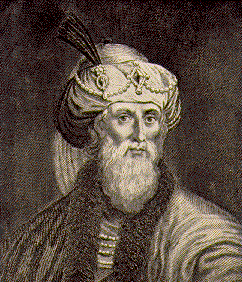"Unusual signs in the ministry of the priests
We are going to be looking at the time when the Temple in Jerusalem was destroyed by the Romans and looking at the period between 30-70 AD to consider some remarkable signs leading up to the destruction of the Temple because some of these very same signs are being repeated in our day. Is it just coincidental? Or could it be that God is trying to send us a message?
Most people know how Titus and the 10th Legion of the Roman Army surrounded the city of Jerusalem in 70 AD, burned the Temple to the ground and took the temple treasures back to Rome. Also he took many of the Jewish people captive that were in the city. Yet most believers today are unaware of the supernatural signs that preceded these historical events.
Jesus Himself predicted the destruction of the Temple and gave the reason why in Matthew 23:34-38. The destruction of the Temple, just like the destruction of Sodom and Gomorrah (Genesis 19) and the flood in Noah's day (Genesis 6:11-13 ), was because of the shedding of innocent blood, the worst form of violence before God.
According to the Jewish Talmud (a book of commentary and discussions by Rabbis), in Yoma 39, there is mention of a number of events or unusual signs that had taken place before but that ceased and never again happened after 30 AD. Before 30 AD, during a 40-year period when a Rabbi by the name of Simeon the Righteous was serving as high priest there were a number of unusual miraculous signs that took place during his ministry as the high priest, that all ceased in the year 30AD. Jewish history tells us that for this 40 year period when Simeon the Righteous was the high priest, prior to 30 AD, these positive supernatural signs took place, then ceased.
What were the signs.
* (1) The drawing of Lots. On the day of atonement, the high priest reached his hand into a box called the lottery and would pull out what some say was a stone, there being a white stone which had written upon it, 'for the Lord' and a black stone which said, 'for azizel'. Then the high priest offered a goat upon the alter as a sacrifice unto the Lord and he laid his hands upon the second goat, called the scapegoat and spoke the sins of the people, which would then be sent into the Judean Wilderness, where it would die, being shoved off a cliff. For centuries, when the high priest reached into that lottery box, it always fell on 'for the Lord', which was the stone removed from the lottery box, until 30AD, when for the first time it fell on 'for azizel.' That continued to happen for the next 40 years. The Jews believed this positive sign to mean that God's blessing was upon them and that He had accepted their sacrifice, but then when 'for azizel' came up in the high priests right hand and kept coming up year after year, they took this to mean God's displeasure upon the priesthood and Israel.
* (2) The second sign was concerning a crimson strap. A red thread was placed around the neck of one of the goats and a red thread around the horns of the other goat. A third red thread or strap was attached to the door of the temple. When the scapegoat was shoved off the hill of the scapegoat in the Judean Wilderness, the red thread on the temple door supernaturally turned white. Isaiah 1:18 says, “Come now, and let us reason together, saith the LORD: though your sins be as scarlet, they shall be as white as snow; though they be red like crimson, they shall be as wool.” According to Jewish history that red thread on the temple door turned white consistently, every year, until 30AD, after which it never turned white again from 30 to 70 AD when the Temple was destroyed.
* (3) The third unusual sign was concerning the Candlestick or Menorah in the Temple. Every morning, the wick had to be changed, fresh oil placed in the Menorah and it had to be lit. During the time of Simeon the Righteous, they always lit the Menorah from the western end of it and then from it they would light the other six branches. What happened beginning in 30 AD, was the western branch went out and they were not able to light the other branches from it.

* (4) The Alter of Sacrifice. During the time of Simeon the Righteous, only two logs were used for the entire sacrifice, they lasted all day during the sacrifices on the Day of Atonement. They needed no other logs for the sacrifices. In 30 AD that miracle ceased and they had to keep putting more logs on the fire to enable them to complete the sacrifices.
* (5) The priest would eat a small amount of bread from the table of shewbread. History tells us that the priest was satisfied by eating a piece of bread the size of an olive. That also changed in 30 AD and the priest was no longer satisfied with that small amount of bread.
* (6) There were doors to the Temple that opened and closed by themselves. In Yoma 39, a commentary on Zechariah 11:1, it teaches that the doors of the temple opened and closed by themselves. The scripture says, “Open thy doors, O Lebanon, that the fire may devour thy cedars.”

All these positive supernatural signs took place until 30 AD, when they ceased and did not happen again for the next 40 years before the destruction of the Temple. Why? Many commentaries have said it was a sign of God's displeasure upon that generation, or God's displeasure upon the illegitimate priesthood appointed by the Romans over the Temple. Though that is true in the natural and the scripture does say that it is first the natural (as a type and shadow) and then the spiritual (1 Corinthians 15:46). But there is something else beyond those things. Hebrews 10:4-10 There were essential defects in these animal sacrifices. 1st.--They were not of the same nature with those who sinned, man. 2nd.--They were not of sufficient value to make satisfaction for the affronts done to the justice and government of God. 3rd.--The beasts offered up under the law could not consent to put themselves in the sinner's room and place. The atoning sacrifice must be one capable of consenting, and must voluntarily substitute himself in the sinner's stead: Christ did so and alone met all the conditions to be our substitute and the propitiation for our sins. Isaiah 53:11
First we have to remember that all these Temple sacrifices and rituals were only a type and shadow to point to Jesus, who was the reality and fulfillment of them. Jesus fulfilled all the types and shadows and sacrifices and made them unnecessary. Let's look at each of the signs.
* (1) Why did the priests' right hand always start picking up 'for azizel' instead of 'for the Lord'? The scapegoat symbolically carried away the sins of the people, transferred by laying on of hands and confession. But this would no longer be needed because Jesus would 'bare our sins' upon the cross and we no longer would need a type and shadow of what He would do for us. Jesus carried the sins of the world. 1 Peter 2:24, Hebrews 9:28, Isaiah 53:11 Jesus became the replacement for the scapegoat, who would bare our sins outside the camp and die for us.
* (2) Why did the red (crimson) thread (strap) on the Temple door no longer turn white after 30 AD? Simply because John 1:29 tells us that Jesus is the Lamb of God who takes away the sins of the world. 2 Corinthians 5:21, Hebrews 1:2-3; 2:17
* (3) Why did the western candle on the Menorah go out, which they couldn't re-light? It was a sign that Jesus was now the light of the world (John 8:12), that His light was now replacing the light of the Menorah for He was the Light of the World. John 1:4-9; 9:5; 12:35-36, Revelation 21:23
* (4) Why did the logs that burned on the brazen altar for the sacrifices for so many centuries, need only two logs because they didn't burn up and go out all day, then required many logs because they burned as normal wood? It was because the fire of the Holy Spirit was no longer going to be on that altar, but on a different one according to Matthew 3:11 and our body would be the temple of the Holy Spirit. Acts 1:5, 2:2-4, 1 Corinthians 6:19-20; 12:13, 2 Corinthians 6:16
* (5) Why did the piece of bread from the table of shewbread no longer satisfy the high priest? Because Jesus was the living bread that came down from heaven and we are told to partake of Him (John 6:35). Satisfaction was now in Jesus, not in physical bread or wine. John 6:48-51; 7:37-38; 4:13-14, Revelation 7:15-17
* (6) Why did the doors of the Temple open and close supernaturally and then cease to do so? Because Jesus was now the way unto the father, the way unto salvation. Jesus said, “I am the door” (John 10:7, 9, 1-5). Ephesians 2:18, Hebrews 10:19-23
Because Jesus came into His ministry in 30 AD and became our high priest, and was revealed as all these things above for His people, these signs were no longer needed to point the way to Jesus for He had come in the flesh and they had Him now. God was saying, the Temple and the Temple sacrifices and rituals are no longer needed and they will no longer be the center of my working among men on the earth. All the types and shadows were replaced with the living Christ, our Messiah. He would become God's sacrifice and would make us the Temple of God and the place on earth where His Spirit would reside and He would now work through His people, who would become kings and priests unto God (Revelation 1:5-6). Matthew 5:14, Mark 16:15-16, John 20:21, Acts 1:8, 2 Corinthians 5:17-20, 2 Timothy 2:2-3
We are a triune being, body, soul and spirit, just as the Temple had three parts, outer court, inner court and holy of holies, where God dwelt. Now, it is within our spirit that His spirit comes to dwell, this temple not made with hands and we are made complete in Him (Colossians 2:10). "
Source:
http://www.hissheep.org/special/hebrew/ ... _days.html 











